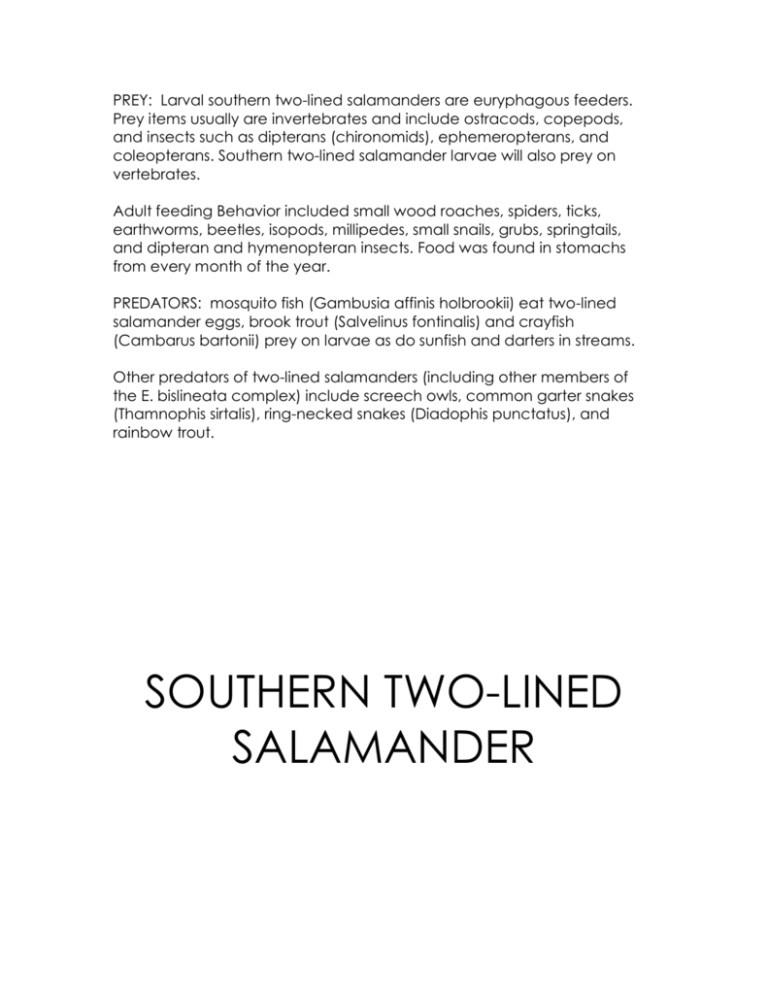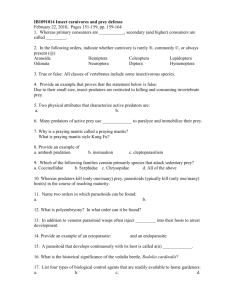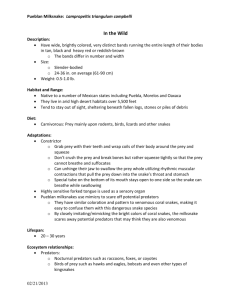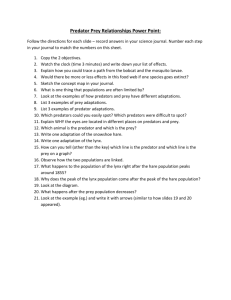Sallie Food Web Game
advertisement

PREY: Larval southern two-lined salamanders are euryphagous feeders. Prey items usually are invertebrates and include ostracods, copepods, and insects such as dipterans (chironomids), ephemeropterans, and coleopterans. Southern two-lined salamander larvae will also prey on vertebrates. Adult feeding Behavior included small wood roaches, spiders, ticks, earthworms, beetles, isopods, millipedes, small snails, grubs, springtails, and dipteran and hymenopteran insects. Food was found in stomachs from every month of the year. PREDATORS: mosquito fish (Gambusia affinis holbrookii) eat two-lined salamander eggs, brook trout (Salvelinus fontinalis) and crayfish (Cambarus bartonii) prey on larvae as do sunfish and darters in streams. Other predators of two-lined salamanders (including other members of the E. bislineata complex) include screech owls, common garter snakes (Thamnophis sirtalis), ring-necked snakes (Diadophis punctatus), and rainbow trout. SOUTHERN TWO-LINED SALAMANDER PREY: Larvae are gape-limited and size-selective feeders, ingesting a range of aquatic invertebrates including zooplankton, coleopterans, isopods, ostracods, odonates, and trichopterans. As they grow in size, consumption shifts towards larger prey such as chironomids, chaoborids, and isopods (Nyman, 1991). Predominant prey items of larvae are cladocerans and copepods, isopods and amphipods. Adults are generalists on forest floor invertebrates, consuming mollusks, earthworms, centipedes, millipedes, spiders, and a wide variety of insects. PREDATORS: Larval wood frogs (Rana sylvatica), centrarchid and cyprinid fishes, and various larval invertebrate species prey on spotted salamander eggs. Eastern newt adults will eat spotted salamander eggs, as will caddisfly and midge (Parachironomus sp.) larvae and other predatory aquatic insects. Wood frog tadpoles will prey on larvae as will least sandpipers. Larval predators also include other Ambystoma species; in regions of sympatry, marbled salamander larvae are already present and will prey on spotted salamander larvae when they. Newly metamorphosed animals and breeding adults are preyed on by raccoons and probably other mammals such as opossums, weasels, and minks. SPOTTED SALAMANDER EASTERN NEWT PREY: Efts forage in the forest floor feeding on invertebrates and have a slight preference for larger prey. Prey include 58 families from 25 orders of invertebrates. Efts cluster around and under mushrooms in late August to September to feed on dipterans attracted to these fungi. Adults are carnivorous, feeding on any available, palatable prey they can swallow whole. Prey include zooplankton, amphipods, mayflies, stoneflies, dipterans, hemipterans, lepidopterans, coleopterans, odonates, oligochaetes, leeches, snails, clams, small fishes, fish eggs, anuran eggs and tadpoles, ambystomatid larvae, conspecific embryos and larvae, and shed skins. Newt predation on the eggs of A. tigrinum can lead to the exclusion of larvae from breeding ponds (Morin, 1983a). Predation by newts has been documented to influence anuran community composition, reducing the size of some populations while freeing others from competition. PREDATORS Many animals feed on eastern newts: smallmouth bass, sunfish (on larvae); snakes (such as hog-nosed), eastern garter snakes and northern water snakes; snapping and painted turtles; mudpuppies; Lesser; marbled salamanders. Raccoons (Procyon lotor) are the main mammalian predator on eastern newts. Leeches appear to be a major source of adult mortality. NORTHERN DUSKY SALAMANDER PREY Larvae feed on copepods, chironomid midge larvae, plecopteran nymphs, collembolans, mites, and fingernail clams. Adults eat caddisflies, larval and adult dipterans, ants, spiders, beetles, sowbugs, caterpillars, earthworms, amphipods, mites, and molted skins and larvae of northern dusky salamanders. Also, amphipods, chilopods, orthopterans, ephemeridans, odonates, hemipterans, lepidopterans, coleopterans, hymenopterans, dipterans, spiders, and one gastropod, mites, collembolans, plecopterans, thysanopterans, homopterans, trichopterans, and sphaeriid clams. Adults eat beetles, lepidopteran larvae, ants, dipteran larvae, an ichneumonid wasp, and a stonefly nymph. Brooding females that had ingested oligochaete annelids. PREDATORS: northern watersnakes and common garter snakes. Blackbellied salamanders (D. quadramaculatus) were reported as predators. Raccoons, skunks, opossums, and other small mammals, snakes, and birds probably eat northern dusky salamanders. Brooding females will cannibalize their own eggs and those of others. Cannibalism by adults on larvae also. PREY: Adults will eat lampreys. Prey on invertebrates such as ostracods, zooplankton such as copepods and cladocerans, snails, annelids, fishes, other species of salamanders, adult eastern worm snakes, isopods, slugs, spiders, crayfish, centipedes, millipedes, and insects such as mayflies, true flies, beetles, dragonfly and damselfly naiads, hellgrammites, caterpillars, and caddisflies. PREDATORS: It is not known whether or not fish prey on Neuse River waterdogs, but workers have speculated that their inactivity during warmer months is in part due to the avoidance of fishes. THREATS: Pesticide and PCB residues. NEUSE RIVER WATERDOG mayflies stoneflies copepods small wood roaches spiders ticks earthworms beetles isopods millipedes small snails grubs zooplankton isopods mollusks centipedes leeches fish eggs anuran eggs tadpoles shed skins caterpillar mosquito fish brook trout small-mouth bass crayfish sunfish darters screech owls hog-nosed snake common garter snakes northern water snake ring-necked snakes Larval wood frogs raccoons opossums weasels minks snapping turtle painted turtle urbanization cars leeches cats cannibalism pesticides








